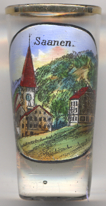

|
| SCHWEIZ / SUISSE / SVIZZERA / SVIZRA | SWITZERLAND |
| Bern / Berne / Berna / Berna |
Saanen (in French: Gessenay), the capital of the administrative district Obersimmental-Saanen, is situated at an elevation of 1,014 m in he upper Saane valley in the southwest of the Swiss canton Bern. The municipality also includes the villlages of Abländschen, Bissen, Ebnit, Gruben, Grund, Gstaad, Kalberhöni, Saanenmöser, Schönried and Turbach, and in total has a population of about 6,800 (2018).
Saanen was first mentioned in 1228 as Gissinay. In 1340 it was mentioned as Sanon. The region was occupied by
the Gallo-Romans until the 10th or 11th century when the Alamanni began to drive them out. This migration created the modern
language borders in Switzerland (see map). During the Middle Ages it was part of the
vogtei (bailiwick) of Vanel in the county of Gruyère. In 1244, the counts became the vassals of Savoy. The counts'
financial problems forced them to sell parts of the vogtei and some of the rights to the residents of Saanen in the
14th century. The village then became the center of the Saanen district and parish. During the Burgundian War in 1475
Saanen, together with troops from Château-d'Œx and the Simmental captured the Savoy
district of Aigle for Bern. Saanen and the surrounding district enjoyed a great deal of
independence during the 16th century. However, in 1555 the last Count of Gruyère lost the entire district to
Bern when his county went bankrupt. Bern took over the entire valley in the following year and introduced the Protestant
Reformation. The Bernese bailiff administered the districts of Gessenay (Saanen) and Pays-d'Enhaut until the great fire of
1575 which destroyed much of the town. The bailiff then moved to the former monastery of Mont Rouge. Until the 1798 French
invasion, the Pays-d'Enhaut and Saanen districts were jointly administered. Under the Helvetic Republic, Pays-d'Enhaut
became part of the Canton of Léman while Saanen and the rest of the district became part of the Canton of Oberland.
When the Helvetic Republic collapsed in 1803, Saanen and its district became a district in the new Canton of Bern. In 1833,
Saanen became a political municipality. Around 1900, tourism began to grow in Saanen and Gstaad and new hotels opened. The
opening of the Montreux–Oberland Bernois railroad in 1905 made it easier for tourists to visit. During both World Wars,
the tourism industry in Saanen suffered, but it has expanded since 1945.

The  church of St. Mauritius [left] was built in 1228. It was expanded
in 1444–1447 in late Gothic style. The wall paintings in the chancel date from around 1470. The church is venue of
the Menuhin Festial Gstaad, founded in 1957 by the violinist and conductor Jehudi Menuhin, and of the winter festival
Sommets Musicaux de Gstaad.
church of St. Mauritius [left] was built in 1228. It was expanded
in 1444–1447 in late Gothic style. The wall paintings in the chancel date from around 1470. The church is venue of
the Menuhin Festial Gstaad, founded in 1957 by the violinist and conductor Jehudi Menuhin, and of the winter festival
Sommets Musicaux de Gstaad.

Glass no. 3930 is labeled on the bottom: “
[https://de.wikipedia.org/wiki/Saanen, https://en.wikipedia.org/wiki/Saanen;
https://de.wikipedia.org/wiki/Kirche_Saanen]
![[scale]](lineal.jpg)